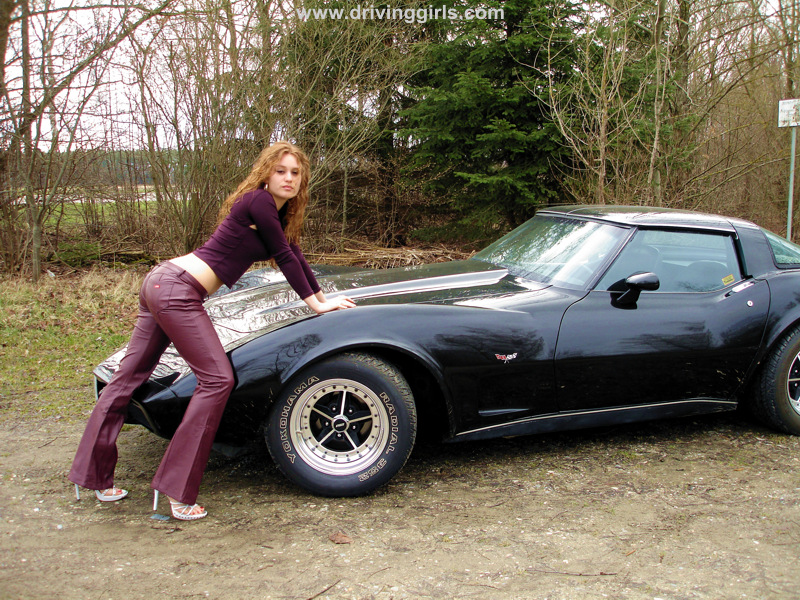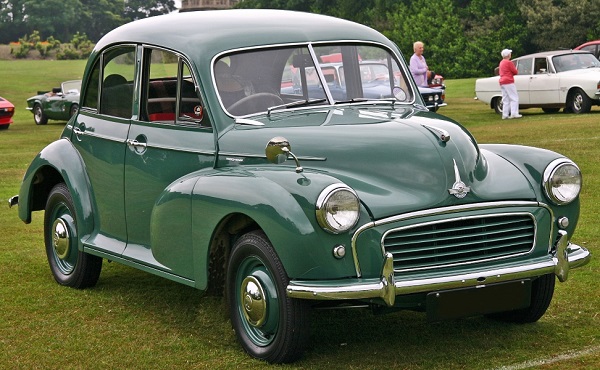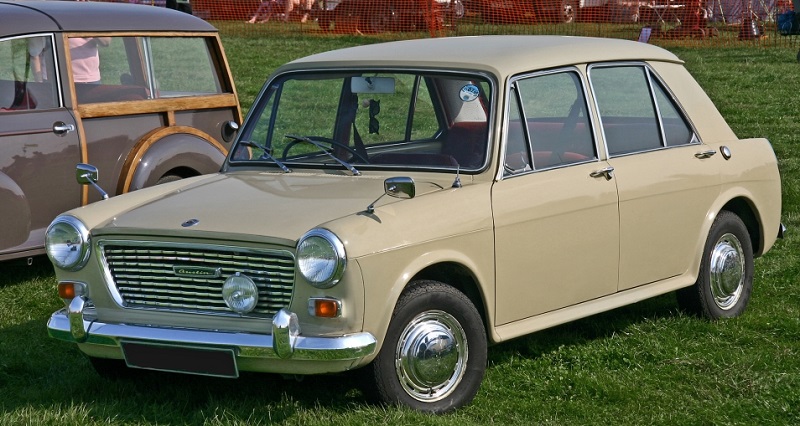“Okay Kim,” you whine, “them furrin cars is all very well, but how ’bout some Murkin goodness?”
Ask, and ye shall receive. Here are the Corvettes:







Go on; you know what to do…

“Okay Kim,” you whine, “them furrin cars is all very well, but how ’bout some Murkin goodness?”
Ask, and ye shall receive. Here are the Corvettes:







Go on; you know what to do…
My mother once had one of these:
Owners of Morris Minors (boasting a top speed of just 63mph, and taking more than 30 seconds to get to 60mph) are among the most prolific drug and drink drivers, a new study suggests.
And it looked exactly like this one:

I think hers had a single windshield, not a split one, but I could be wrong. She loved it dearly, and was distraught when my father secretly sold it, replacing it with one of these:

She kept the Austin-Healey for almost a year, then forced my father to get rid of it, “because the men keep looking at me and flirting” — which tells you all about my mother. Its replacement? An Austin 1100:

…which she kept for years until I wrecked it in 1971 (sorry, Ma).
Anyway, about that drunken Morris Minor driver thing: I suspect that it’s because most Minor drivers today are old farts, who suffer from impaired reflexes and decaying driving skills as well as a tendency to drink lots of gin.
I want to drive a Morris Minor then, because I fit the profile perfectly. But I want the Traveller model, complete with wood (which is real wood, by the way):

I bet I could pull the chicks* with that beauty, big time.
* of my own vintage, that is.
I don’t do well by myself. Today I dropped the Tiguan off at the Eurocar repair shop to have the back brakes replaced (after only 65,000 miles — whatever happened to quality?). The owner of the place very kindly offered me a lift home, which offer I gratefully accepted.
And then it all went pear-shaped. You see, I always drop the deadbolt on the front door when I leave the house because I go out through the garage.
You know where this is going, right?
Yup; the garage door opener is still in the Tiguan, ten miles away, and my front door key is useless because deadbolt.
So I sidled off to the apartment complex manager to see what could be done. Long story short: nada. For security reasons, there is no universal remote for the garages, and as with the front door, the patio door is likewise deadbolted. I am marooned for the next four hours or so, and I don’t like it.
Follow my reasoning, here: if I had a wife, she’d be at home to let me in, with a steaming cup of consoling coffee withal, and I wouldn’t be sitting here typing on the complex’s public computer with only the lovely Claudia in the office to look at, listening to the canned “boom-tsss, boom-tss, boom-tss” background music supporting the usual helium-voiced Black chick singing crap lyrics in nigh-incomprehensible Ebonics.
Or maybe it’s Taylor Swift singing. I’m not sure because tinnitus makes it difficult to hear anything through the World’s Cheapest Speakers echoing through the hard-floored hard-walled curtainless office complex.
This wife thing may seem to be something of an extreme remedy for the (very) occasional circumstance of locking oneself out of the house; but there are plenty of other reasons, such as the fact that my last sexual encounter with a woman was during the Bush presidency (and don’t ask which one, either). Another reason for me to have a wife is that I am absolutely sick of my own cooking — a man can only eat so much steak, shrimp, toasted cheese or -chicken sandwiches, coleslaw, lamb vindaloo, Jarlsberg cheese, bacon & eggs, grilled boerewors, baby back ribs, grapefruit segments, sausage rolls, steak ‘n kidney pie, ice cream, and baked beans on toast for so long before he dies of the dreaded Gastric Boredom. Some variety, in other words, is needed.
Speaking of need, I need a drink, but of course old-fashioned hospitality has disappeared because offering a cocktail to a man in dire straits is nowadays something Only Hitler Would Do, or so I’ve heard. If I had a wife, I’d never have that problem because anyone I’d marry would know that when I need a drink, I need a drink and that’s the end of it.
So I’m announcing today that I am now in the market for a wife, on a first-come first-served basis, so to speak. And while all offers will be closely scrutinized, I should remind all lonely desperate needy partners that I am, to put it very mildly, a terrible prospect and you would be better off hooking up with Hitler. Or something like that.
Unless Maintenance somehow manages to find some way into my apartment and gets me inside, in which case never mind.
Judging from my overfilled Inbox, it seems as though this series may be quite popular. So without any further ado, here are some creations of Herr Doctor Ferdinand:







Given that I think that most Porsches are hideously ugly, it’s easy to see where I stand on which is beauty and which the beast.
As always, you may vote for your favorite (car, of course).
My friend Doc Russia has a fixation about being prepared for any eventuality. His gun collection is, shall we say, comprehensive — so much so that the last time he rode out with the North Texas SWAT team (a gig he volunteers for, uncompensated), he arrived with his latest toys and one of the guys burst out: “Damn, Doc! You’ve got better gear than we have.” And it’s true.
One of the things that the SWAT guys need is transportation for the emergency doctor who rides out with them — to be more specific, transportation for Doc’s successor, because of course, Doc’s ride (which we his friends dubbed the “Doom Wagon”) could probably not only survive a nuclear blast, but also outlast the cockroaches which would survive that. Even Keith Richards would shake his head and give up.
For those who are interested in such things, it’s a Toyota 4Runner, although after he’d finished with the mods, it looked like nothing Toyota ever dreamed of. Here are a couple pics, just for you to get the idea:


All this came from Doc’s need to be prepared for any eventuality: it’s a bugout wagon par excellence, and as you can see from the latter pic, it carries spare fuel (it has to, ‘cos it be thirsty, mon). Also inside is a giant medical bag, to save lives, and to take lives (if necessary), a semi-auto rifle in a hidden compartment and a spare Glock 17 in the glove box, along with shall we say an adequate sufficiency of ammo for both. Alert Readers will have seen the light bar, and the snorkel for deep-water fording, but would not have seen the massive steel underbody plate, the beefed-up adjustable suspension or the built-in air compressor (to be able to re-inflate a tire in case of a puncture).
So much do the SWAT guys covet this beast that Doc promised to transfer it over to them should he ever have to quit the gig, so his replacement would have its full use. (It’s even deeded to N. Texas SWAT in his will.)
I don’t know why I’m using the present tense in all this, because last week the Doom Wagon was stolen out of the hospital parking garage while Doc was on duty in the ER. According to an eyewitness, it wasn’t gone in sixty seconds; the pro team of thieves (which it must have been) only needed about half that before driving off in it.
So while Doc was saving lives in the emergency room, some fucking bastards stole his truck.
He’s insured, of course, but that’s not the point. I’ve been with him almost all the way in his quest to create the perfect utility vehicle — we’ve sat and talked and argued about this option versus that option, weighing cost vs. performance vs. utility and so on — and in the end, all for nothing: gone to a mope with a crowbar and a screwdriver.
Here’s what’s interesting. Needless to say, Doc’s medical kit and the two guns with it are also gone, but that’s not what bothers him the most.
You see, his eight-year-old daughter’s favorite water bottle, complete with her name engraved on it, was also in the truck — and when I picked him up from work, he was most upset that he was going to have to explain to her that yes, there are bad people in the world, and because of them, she’ll never see her water bottle again. It would have been her first experience of evil because like most good parents, he’s tried to shield her from the ugliness as much as he could. No more.
You don’t want to hear the details of our revenge fantasies, should we ever lay hands on these bastards.
As Sundays at this address seem to have degenerated into discussions of beauty (with a little gratuitous leering thrown in — you animals), I had an idea for a new series: beautiful cars, suitably accessorized.
Here, for example, is the Ferrari thread:







Your votes in Comments.
Next week (unless y’all hate this idea): another brand.